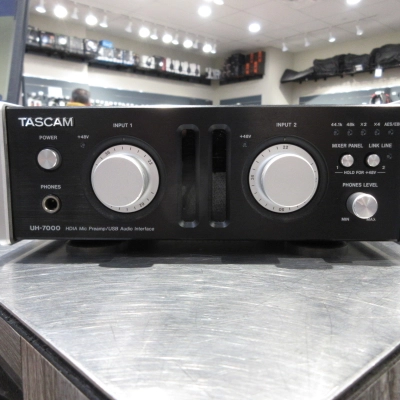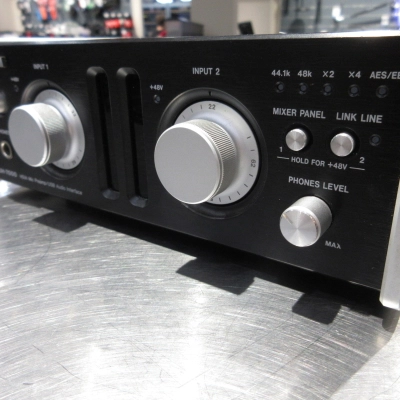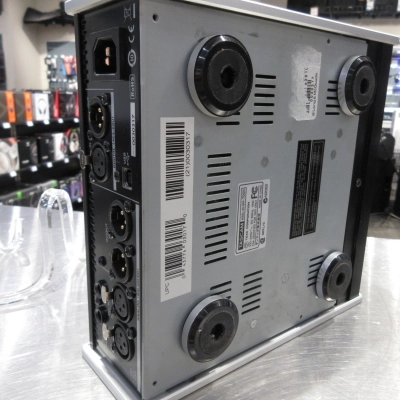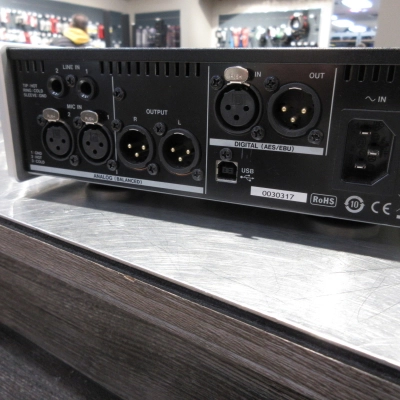Gear Hunter
Tascam - UH-7000




Buy From Store
Pick up at the store only. Contact Toronto (Bloor St.) Ontario
This product may not come in original packaging.
Description
4-channel USB Audio Interface/Mic Preamp with HDIA Preamps
Ask Audio Mag Best of 2014 The UH-7000 is a pro-level microphone preamp and audio interface, designed with a strong focus on low noise and high audio quality. Not only can this unit be used as a 4-in/4-out audio interface in a DAW production environment, but as a standalone microphone preamp and AD/DA converter. The built-in HDIA (High Definition Instrumentation Architecture) microphone preamps are newly designed with low noise and high audio quality. These impressive mic pres perform at −128dBu EIN, a 117dB signal-to-noise ratio and distortion ratio of 0.0009% or less.
The grand nature of the UH-7000's sound is partially due to the careful attention spent on selecting parts. In addition to the Burr-Brown PCM4220 ADC, PCM1795 DAC converters and thin film metal resistors, installed is a powerful TCXO clock generator with +/−1ppm precision.
The units half-rack size makes it easy to install at a studio console or work desk. The thick aluminum panels on the front and sides of the full-metal body increase stability. Highly important but easily forgotten are the smooth-tension aluminum input level knobs for precise level adjustments.
The UH-7000 microphone preamp and audio interface enables composers, musicians and recording engineers to produce music in their private quarters at a level only reached in professional studios.
MAIN FEATURES
HDIA mic preamps capture detailed nuances
The High Definition Instrumentation Architecture (HDIA) mic preamp maximizes high specifications that produce the lowest noise. Parts were selected through repeated listening tests in order to confirm high-performance in both numerical ratings and actual audio quality. The instrumentation amplifier method requires a large number of parts and labor, therefore it is rarely used in ordinary audio equipment. Designed with a circuit that is used not only for professional audio equipment but also in measurement devices that handle highly detailed signals, the UH-7000 is capable of capturing the finest expressive nuances for all musical performances.
Excellent input audio circuit specifications
The analog audio input circuit was designed to achieve low noise and high audio quality throughout the entire signal. Key parts only made the cut after many intense listening tests. Everything from the film capacitors for improved noise performance to the thin film metal resistors and others.
Equivalent Input Noise (EIN): −128 dBu
Audio equipment generates a small amount of voltage even when all input/outputs are disconnected. This noise is calculated as equivalent input sound pressure, most commonly known as equivalent input noise (EIN). Signals at levels lower than this value are masked. -128 dBu represents the smallest signal level the UH-7000 can actually handle.
Signal-to-noise (S/N) ratio: 117 dB (mic to AD converter)
The signal-to-noise (S/N) ratio is a logarithmic value that expresses the amount of noise in comparison to the signal. As a value that indicates the performance of audio equipment, it is extremely important. As this value increases, the amount of noise decreases.
Total harmonic distortion (THD): 0.0009% or less (mic to AD converter)
With no distortion being the ideal, this value expresses the distortion (harmonic content) from the circuit. As this value decreases, the amount of distortion also decreases. Most other USB audio interfaces cannot reach THD levels this low.
Frequency Response: 20 Hz to 80 kHz, +0.005 dB/−0.16 dB (mic preamp at all sampling frequencies)
The frequency response used for audio equipment expresses the sound pressure frequency characteristics. Since this showcases how each frequency of the input audio (sound pressure amplitude) varies, it is often shown as a graph. When expressed numerically, the frequency range and amplitude variation values are used. The ideal value is a straight line graph from the lowest frequency to the highest frequency. The closer the response is to being flat, the more accurately the characteristics of the source sound are maintained. People tend to focus on the frequency range, but the amplitude variation is very important. For example, "20 Hz20 kHz, +/−1 dB" is closer to being flat than "20 Hz20 kHz, +/−6 dB".
FEATURES AT A GLANCE:
- Supports 24-bit/192kHz USB transmission and AD/DA conversion
- Support for Mac and Windows operating systems
- 4-in/4-out audio streaming from a PC connected via USB 2.0
- Burr-Brown PCM4220 AD converter
- Burr-Brown PCM1795 DA converter
- HDIA mic preamps: 128dB EIN
- Thin film metal resistors with outstanding noise performance
- High audio quality film capacitors with low distortion
- Low latency monitoring through the DSP mixer
- DSP mixer can be switched between multitrack and stereo mix modes
- DSP mixer enables independent adjustment of recording and monitoring levels
- Line or digital outputs can be selected using the DSP mixer
- DSP dynamics effect can be applied to inputs, outputs or the master (compressor, noise suppressor, de-essoer, exciter, EQ, limiter/low cut)
- DSP REVERB (hall, room, live, studio, plate) send effect is perfect for monitoring when recording
- Link line function enables volume control of powered monitors
- Single punch MIXER PANEL button
- Strong, highly durable aluminum body
- Large INPUT level knobs enable precise adjustment of input levels
- Two 20-segment LED level meters
- Standard TRS headphones output jack - 45mW/channel output
- +48 Phantom power supply
- Two balanced analog XLR jacks for both input and output
- Professional output specifications (maximum output level: +24 dBu)
- Two balanced analog TRS input jacks
- XLR digital input and output jacks support AES3-2003/IEC60958-4 (AES/EBU) and IEC60958-3 (S/PDIF) formats
- Three-pronged inlet power cable
- Half-rack size
- Confirmed operation with major DAW software, including Sonar X3, ProTools, Cubase and Live
- RoHS Compliant

